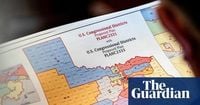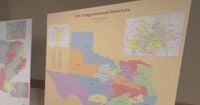The battle over Texas’ congressional maps has taken a dramatic turn, with the U.S. Supreme Court stepping in to temporarily halt a lower court’s ruling that found evidence of racial gerrymandering in the state’s new district lines. On November 22, 2025, Supreme Court Justice Samuel Alito signed an order granting Texas’ request for an administrative stay, allowing the state to use its 2025 congressional map—at least for now—while the high court determines the legality of the redistricting plan. This decision comes as the clock ticks toward the December 8 candidate filing deadline for the 2026 midterm elections, a timeline that both sides acknowledge adds urgency to the legal wrangling.
According to The Dallas Morning News, Texas Attorney General Ken Paxton moved quickly after a three-judge federal panel barred the state from using its newly drawn map, which had been approved by the Republican-controlled legislature and signed into law by Governor Greg Abbott in August. The panel’s ruling, issued on November 18, 2025, ordered Texas to revert to its 2021 district lines, citing “substantial evidence” that the 2025 map was racially gerrymandered. Judge Jeffrey Brown, a Trump appointee, wrote in his opinion, “To be sure, politics played a role in drawing the 2025 Map. But it was much more than just politics. Substantial evidence shows that Texas racially gerrymandered the 2025 Map.”
Justice Alito’s stay is only temporary, but it has immediate consequences: it keeps in place a map that gives Republicans five additional House seats ahead of the 2026 elections. This outcome is precisely what former President Donald Trump advocated for earlier in the summer, when he urged Texas Republicans to redraw boundaries to bolster the GOP’s slim majority in the U.S. House of Representatives. As Crossroads Today reported, Alito asked the plaintiffs to respond to Texas’ motion by the end of Monday, November 24, 2025, signaling that the Supreme Court is moving swiftly—at Texas’ request—to resolve the dispute before the candidate filing window closes.
Attorney General Paxton has been vocal about his defense of the new map, both in court and on social media. Announcing the Supreme Court’s intervention on X (formerly Twitter), Paxton called the stay a victory and reaffirmed his commitment to fighting the case on its merits. “Texas engaged in partisan redistricting solely to secure more Republican seats in Congress and thereby better represent our state and Texans,” Paxton insisted, as quoted by Benzinga. He added that Texas will “continue to press forward in our case on the merits.”
But not everyone sees the redistricting as a fair exercise in partisan politics. The process has drawn fierce criticism from Democrats at both the state and national levels. In August, more than 50 Texas House Democrats fled the state in an attempt to deny the Republican majority the quorum needed to approve the new maps, a dramatic move that underscored the high stakes of the redistricting fight. In response, Paxton filed a lawsuit with the Texas Supreme Court seeking to remove 13 absent lawmakers, though the effort ultimately did not prevent the passage of the map.
The controversy has also attracted attention from national figures. Former President Barack Obama weighed in, calling the Texas redistricting effort “a power grab that undermines our democracy.” According to Benzinga, Obama’s criticism added fuel to an already heated debate about the role of race and partisanship in drawing congressional boundaries. The Texas case is not happening in isolation; it is part of a broader, nationwide battle over redistricting. Other Republican-led states, such as North Carolina and Missouri, have also redrawn their maps in ways that favor the GOP, while California passed Proposition 50, a measure designed to give Democrats more favorable districts.
At the heart of the Texas dispute is the question of whether the state’s 2025 map crosses the line from permissible partisan gerrymandering into unconstitutional racial gerrymandering. The three-judge panel’s majority found that it did, citing evidence that the new lines diluted the voting power of minority communities. Judge Jeffrey Brown’s opinion was clear: “Substantial evidence shows that Texas racially gerrymandered the 2025 Map.” However, not all judges agreed. Judge Jerry Smith of the 5th U.S. Circuit Court of Appeals issued a strong dissent, arguing that the evidence did not support the majority’s conclusion and that the courts should not interfere so close to an election cycle.
The Supreme Court’s involvement adds yet another layer of complexity. The high court has made clear that its stay is not a final decision on the merits of the case. Instead, it is a temporary measure designed to prevent “further disruption,” as Paxton put it, while the justices consider the legal arguments. Alito’s order specifically requested that the justices issue a ruling before 5 p.m. on Monday, November 24, 2025—a tight deadline given the looming candidate filing date.
As campaigning for the 2026 midterms is already underway, the uncertainty over which map will ultimately be used has left candidates, parties, and voters in a state of suspense. For Republicans, the 2025 map represents a chance to solidify their grip on Texas’ congressional delegation, potentially influencing the balance of power in Washington. For Democrats and voting rights advocates, the fight is about ensuring that minority communities are not unfairly marginalized in the political process.
The Texas redistricting saga is emblematic of the broader national struggle over voting rights, representation, and the boundaries of partisan advantage. As other states redraw their maps and legal challenges proliferate, the Supreme Court’s eventual ruling in the Texas case could have far-reaching implications for how congressional districts are drawn across the country. For now, though, all eyes are on the justices—and on Texas—where the outcome of this legal battle will shape not only the state’s political landscape, but potentially the nation’s as well.
With the December 8 filing deadline fast approaching and the Supreme Court poised to weigh in, the fate of Texas’ congressional map hangs in the balance. The coming days will determine not just the lines on a map, but the contours of American democracy in a pivotal election year.






